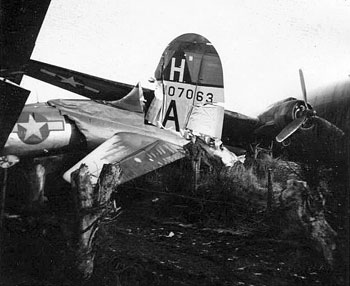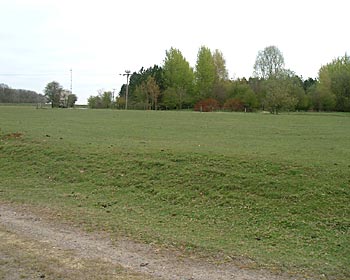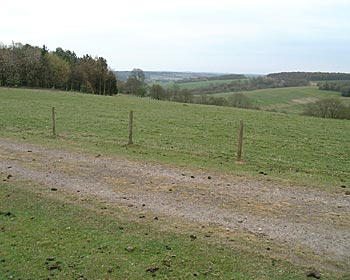B17
G Flying Fortress, 42-107063
367th Bomb Squadron, 306th Bomb Group, US 8th Air Force
Membury
30th November 1944

This landing accident occurred on the afternoon of 30th November 1944 following a cross-country flight from Thurleigh, Bedfordshire. Although the aircraft's brakes were functioning properly, the runway was slippery and the tyres would not hold. According to those who witnessed the accident the pilot should have touched down on to the runway sooner than he did - other B17 and B24 visitors to Membury had in the past landed on the same runway without difficulty. However the pilot, 1st Lt. Leland Deck, felt that he had landed well within the first third of the runway and that the accident was entirely due to the slippery conditions.
Once the B17 started to skid, First Lt. Deck tried desperately to gain control by cutting numbers two and three engines and continually applying and releasing the brakes. He soon realised that he wasn't going to stop in time and tried to ground-loop the aircraft, but was unable to control its direction. The plane shot off the end of the runway at a speed of about 40 mph. The right wheel fell in to a hole causing the right wing to drop and the engines to dig in. It then skidded over a small embankment and across a road before coming to a halt. The only member of the crew to receive injuries was the navigator, 1st Lt. Theodore Cumberledge. X-rays showed that he had sustained several cracked or chipped vertebrae.
The wrecked
B17 remained at at the end of Membury's runway for over a week before a team
from the 2nd Strategic Air Depot arrived to remove it. Joe Kendrick was a member
of that team and has vivid memories of his short stay at Membury. "I
was a member of an aircraft recovery team working out of the Second Strategic
Air Depot (near Huntingdon) that was sent to Membury to dismantle this aircraft.
The plane had come to a stop right at the boundary of the aerodrome and at a
point directly in line with the runway. Fortunately, tests of dual glider takeoff
procedures were being conducted on a different runway, but the one we were positioned
at the end of was heavily used and as we worked, aircraft were frequently taking
off and passing over us at very low altitudes. Scariest were a few instances
when the plane taking off was a transport version of the B-24 Liberator bomber.
They passed extremely low and their four engines and screaming superchargers
made it most difficult for us to concentrate on our work. Also, landing aircraft
were ending their rolls and turning off to the perimeter track just a short
distance away. We were acutely aware of the possibility that another plane could
overrun, just as the one we were working on had done. Luckily, when what we
feared became reality two or three days into the job, we had gone to the mess
hall for lunch. The C-47 that crashed into the B-17 was one of many that were
arriving with loads of wounded troops, most of them from Patton's army. The
ambulance plane had slowed considerably and I don't think anyone was hurt".
"This second damaging of the B-17 changed the nature of our task. We had
been working to carefully disassemble the plane so that the large components
could be used for replacement parts intact We now began the removal of smaller
pieces of equipment, and soon a pair of 6X6 trucks arrived from 2nd SAD to pick
them up. Another fellow and I were working in the bomb bay, one on either side,
standing on the bomb bay doors removing shackles, lights, and other small parts,
when suddenly the doors opened beneath us and down we plunged. Neither of us
dared to try grabbing anything to hold onto for there were too many sharp edges.
It happened that the plane had stopped with the bomb bay precisely above what
appeared to be an ancient deep cut narrow road that passed just outside the
aerodrome fence, so our fall was seven or eight feet. Uninjured, but jarred
and highly ticked off, we climbed out and up into the airplane to find out who
was responsible for our getting salvoed. There, we saw one of the truck drivers
coming out of the cockpit with a big smile on his face. In his hand he had the
big red ball that had been located alongside the pilot's seat. In an emergency,
a pull on the ball simultaneously open the bomb bay doors and jettisoned the
bomb load. Truck drivers liked the balls for their gear shift knobs, and were
always scrounging them when an airplane was being salvaged. This fellow had
pulled up on the ball so he could cut the cable that ran to the bomb bay. My
co-worker and I restrained ourselves and didn't attack him physically, but we
gave him a thorough verbal going over. He just walked away to his truck, still
smiling".
B-17 Crew
details
Pilot - 1st Lt. Leland P.
Deck
Co-pilot - 2nd Lt. William D. Carder
Navigator - 1st Lt. Theodore C. Cumberledge
Engineer - Sgt. A.A. Stedina
Passenger - 2nd Lt. Ellery A. Bennett


Above
left: On 12th December 1944 C-47 43-16368 from the 27th Transport Group
overshot runway 230 and collided with B-17 42-107063.
The bomber was being dissmantled by a team from the 2nd Strategic Air Depot.
Fortunately, at the time if the incident the team was
in the mess hall eating lunch (Joe Kendrick).
Above right: The same spot 60 years on. The tree line
marks the south-western end of runway 230.
When Lt. Deck's B-17 reached this point it was still travelling at about 40
mph.
Below: After leaving the runway the B-17 careered over
a grass strip eventually coming to rest straddled across the road in the foreground.

©
Copyright 2004 Roger Day